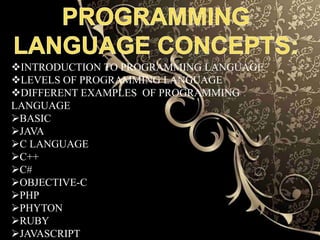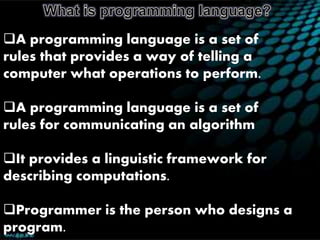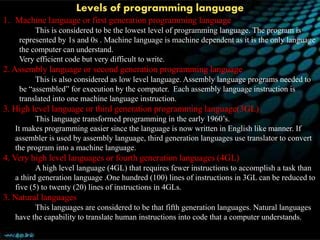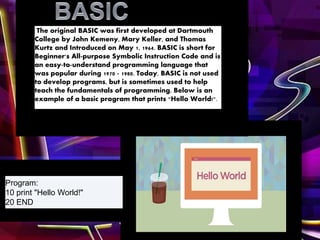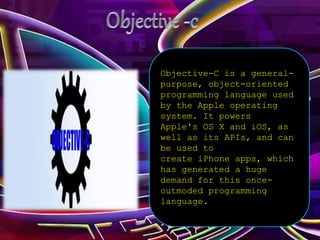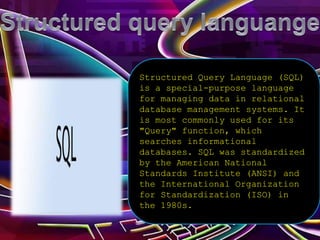Programming language (JGMNHS)
- 2. SHARMILAH BAUTISTA KATHERINE GAMBOA INTRODUCTION TO PROGRAMMING LANGUAGE LEVELS OF PROGRAMMING LANGUAGE DIFFERENT EXAMPLES OF PROGRAMMING LANGUAGE BASIC JAVA C LANGUAGE C++ C# OBJECTIVE-C PHP PHYTON RUBY JAVASCRIPT
- 3. A programming language is a set of rules that provides a way of telling a computer what operations to perform. A programming language is a set of rules for communicating an algorithm It provides a linguistic framework for describing computations. Programmer is the person who designs a program.
- 4. Levels of programming language 1. Machine language or first generation programming language This is considered to be the lowest level of programming language. The program is represented by 1s and 0s . Machine language is machine dependent as it is the only language the computer can understand. Very efficient code but very difficult to write. 2. Assembly language or second generation programming language This is also considered as low level language. Assembly language programs needed to be “assembled” for execution by the computer. Each assembly language instruction is translated into one machine language instruction. 3. High level language or third generation programming language(3GL) This language transformed programming in the early 1960’s. It makes programming easier since the language is now written in English like manner. If assembler is used by assembly language, third generation languages use translator to convert the program into a machine language. 4. Very high level languages or fourth generation languages (4GL) A high level language (4GL) that requires fewer instructions to accomplish a task than a third generation language .One hundred (100) lines of instructions in 3GL can be reduced to five (5) to twenty (20) lines of instructions in 4GLs. 3. Natural languages This languages are considered to be that fifth generation languages. Natural languages have the capability to translate human instructions into code that a computer understands.
- 6. The original BASIC was first developed at Dartmouth College by John Kemeny, Mary Keller, and Thomas Kurtz and Introduced on May 1, 1964. BASIC is short for Beginner's All-purpose Symbolic Instruction Code and is an easy-to-understand programming language that was popular during 1970 - 1980. Today, BASIC is not used to develop programs, but is sometimes used to help teach the fundamentals of programming. Below is an example of a basic program that prints "Hello World!". Program: 10 print "Hello World!" 20 END
- 7. JAVA is a class-based, object- oriented programming language developed by Sun Microsystems in the 1990s. It's one of the most in-demand programming languages, a standard for enterprise software, web-based content, games and mobile apps, as well as the Android operating system. Java is designed to work across multiple software platforms, meaning a program written on Mac OS X, for example, could also run on Windows.
- 8. A general-purpose, imperative programming language developed in the early '70s, C is the oldest and most widely used language, providing the building blocks for other popular languages, such as C#, Java, JavaScript and Python. C is mostly used for implementing operating systems and embedded applications. Because it provides the foundation for many other languages, it is advisable to learn C (and C++) before moving on to others.
- 9. Pronounced "C-sharp," C# is a multi-paradigm language developed by Microsoft as part of its .NET initiative. Combining principles from C and C++, C# is a general-purpose language used to develop software for Microsoft and Windows platforms.
- 10. C++ is an intermediate-level language with object-oriented programming features, originally designed to enhance the C language. C++ powers major software like Firefox , winamp and Adobe programs. It's used to develop systems software, application software, high- performance server and client applications and video games.
- 11. Objective-C is a general- purpose, object-oriented programming language used by the Apple operating system. It powers Apple's OS X and iOS, as well as its APIs, and can be used to create iPhone apps, which has generated a huge demand for this once- outmoded programming language.
- 12. PHP (Hypertext Processor) is a free, server-side scripting language designed for dynamic websites and app development. It can be directly embedded into an HTML source document rather than an external file, which has made it a popular programming language for web developers. PHP powers more than 200 million websites, including Wordpress, Digg
- 13. Python is a high-level, server- side scripting language for websites and mobile apps. It's considered a fairly easy language for beginners due to its readability and compact syntax, meaning developers can use fewer lines of code to express a concept than they would in other languages. It powers the web apps for Instagram, Pinterest and Rdi o through its associated web framework, Django, and is used by Google, Yahoo! and NASA
- 14. A dynamic, object-oriented scripting language for developing websites and mobile apps, Ruby was designed to be simple and easy to write. It powers the Ruby on Rails (or Rails) framework, which is used on Scribd, GitHub, Groupon and Shopify. Like Python, Ruby is considered a fairly user-friendly language for beginners.
- 15. JavaScript is a client and server-side scripting language developed by Netscape that derives much of its syntax from C. It can be used across multiple web browsers and is considered essential for developing interactive or animated web functions. It is also used in game development and writing desktop applications. JavaScript interpreters are embedded in Google's Chrome extensions, Apple's Safari extensions, Adobe Acrobat and Reader, and Adobe's Creative Suite.
- 16. Structured Query Language (SQL) is a special-purpose language for managing data in relational database management systems. It is most commonly used for its "Query" function, which searches informational databases. SQL was standardized by the American National Standards Institute (ANSI) and the International Organization for Standardization (ISO) in the 1980s.


